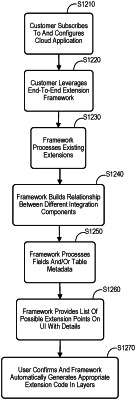| CPC G06F 16/2448 (2019.01) [G06F 11/3457 (2013.01); G06F 16/256 (2019.01)] | 19 Claims |

|
1. A system to facilitate extensibility for an enterprise portal, comprising:
a business enterprise portal data store containing information about the enterprise portal for multiple technical layers of a cloud computing environment including an enterprise portal design system layer, a cloud application programming model framework, a cloud integration layer, and an Enterprise Resource Planning (“ERP”) solution layer; and
a multi-level extensibility framework server, coupled to the business enterprise portal data store, including:
an extensibility relationship framework to extract metadata from the multiple technical layers regarding existing artifacts and mappings, wherein the extensibility relationship framework includes a metadata reader, a metadata parser, and a relationship builder;
a computer processor, and
a memory storage device, coupled to the computer processor, including instructions that, when executed by the computer processor, enable the multi-level extensibility framework server to:
(i) provide to a user a graphical view of existing services of the enterprise portal using information from the business enterprise portal data store and a sample data model,
(ii) receive from the user extension information for at least one of the technical layers and, based on the received extension information, automatically generate and provide an intelligent extension proposal to the user based on information from the extensibility relationship framework,
(iii) display simulated results to the user based on the intelligent extension proposal and the sample data model, and
(iv) receive from the user a confirmation of the intelligent extension proposal and automatically transfer extension fields, entities, and mapping to the multiple technical layers of the enterprise portal.
|